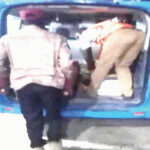
Clinical psychologists, neurologists and neurodevelopmental therapists have cautioned parents against trying to switch a left-handed child to a right-handed one, saying it may lead to neurodevelopmental disorders.
They noted that being left or right-handed is both natural and that every child is unique and can lead a happy, fulfilling life irrespective of which hand they show a preference for.
A Clinical Psychologist and founder, Mentoring Mentees, Dr. Candyfidel Onuraokoye, described neurodevelopmental disorders as a group of neurological disorders that affect the development of the nervous system, which tends to live with the person.
He noted that handedness is a person’s preferential use of one hand (dominant) since such a hand is stronger, faster or more dexterous in performing certain tasks.
He described the less dextrous hand as non-dominant.
The clinical psychologist said the neurological disorders could lead to abnormal functioning of the brain and advised that left-handed children be allowed to develop accordingly as forcing them to switch affects their emotions, learning ability, self-control and memory.
Forcing a child to switch hand use preference is an unwise decision taken out of ignorance by parents, teachers and society, he said.
Dr. Onuraokoye noted that the dominant writing hand is not just a physical exercise of controlling a pen, but the way the brain is cross-wired.
He explained that the brain is programmed in such a way that the left cerebrum controls the activities on the right side of the body, while the right hemisphere controls the left activities.
The clinical psychologist insisted that any alteration in this neurological arrangement has grave implications for the child’s development.
Dr. Onuraokoye listed some of the reported negative impacts of such a switch to include bad handwriting, bed-wetting, stuttering, nail-biting, shyness, defiance and provocative behaviours, poor concentration, bad memory, reading difficulties, problems with spelling and neurotic personality.
“For many years, when research and data were unavailable, many left-handed children were forced by their parents or schools to change hands and this ruined many children’s intelligence and made them nervous in handling tasks,” he added.
A Neurologist and Medical Director, Chidicon Medical Centre, Owerri, Imo State, Professor Philip Njemanze, said the idea of converting a left-hand user to a right, is wrong.
He said, “The brain of a child has stored instinctual data in the right brain (Cerebrum) and has created it to work with that. So, when such an act of correction comes, it tries to disrupt intellectual order by imposing it on the child, even as the brain has programmed it.”
According to Njemanze, who is also the Chairman, International Institutes of Advanced Research and Training, CMC, people mechanically try to turn the data to another side, noting that each time the child wants to undertake any task, he experiences confusion in the central information system.
“As children grow older, they tend to favour one hand over the other for certain tasks, especially for writing or drawing. A child’s handedness is generally categorised as right, left, or mixed. It tends to settle around the same time they acquire language — about four years old. Then, it remains a persistent characteristic throughout his life.
“A child’s handedness says something about the organisation and function of his brain. The left and right hemispheres of the brain control motor action on the opposite sides of the body. Yet, the left and right halves of the brain are not equal in their control of different types of behaviours. This results in a bias of one hand over the other for certain tasks,” the neurologist said.
Describing the dominance of one hemisphere over the other for certain behaviours such as cerebral lateralisation, Njemanze, who also majored in neurosurgery, said there are clear reasons for the evolution of cerebral lateralisation.
According to the National Library of Medicine, cerebral lateralization refers to the functional specialisation of the two cerebral hemispheres. Noting that whereas, the left hemisphere of most adults is more active than the right during language production.
Speaking further, Dr. Njemanze noted that lateral disorder confuses the child when there is the need to take certain urgent actions because the information centre has been tampered with.
A report by First German Consulting and Information Centre for Left-handers and Converted Left-handers, titled, ‘The Primary and Secondary Consequences of Converting Handedness,’ affirmed that conversion of inborn handedness, which is being carried out on the basis of societal prejudices has serious consequences, especially if one is using the non-dominant hand to write.
It stated that the conversion is contrary to the natural state of the human being, noting that converting handedness does not result in the conversion of brain dominance; instead, it results in an over-loading of the non-dominant half of the brain and an under-loading of the other half.
“Accordingly, there are also resulting difficulties in transference in the corpus callosum which in turn, could probably result in the appearance of the widest range of primary consequences.
“Writing is a process of the greatest complexity. Moreover, because it involves many different brain functions, it is also one of the most difficult tasks; one which only human beings have developed and come to grips with.
“The predominant use of the non-dominant hand leads to complex functional disturbances, inhibitions, blockages, and an over-burdening of the entire brain. During writing, the greatest variety of cerebral skills, are included. Examples are the fine motor skills, speech, and the pictorial representation of imagination of the series of letters as well as the simultaneous chain of thoughts, graphic representations, memories, and recall of previously learned material which also run throughout.”
The report noted that there is scarcely any other human undertaking comparable to writing in its multifaceted connections between the most differing brain functions, adding that the overburdening that comes from converting handedness can lead to tremendous disturbances.
“The possible primary consequences of converting handedness are memory disorders; disturbances in concentration; legasthenic problems or dyslexia; spatial disorientation (uncertainty concerning the left and right); disorders in fine motor skills that manifest themselves in handwriting; and disturbances in speech ranging from stammering,” the report added.
‘Bias Against Left-handed People,’ a work published by Wikipedia.com, reads, “Owing to cultural and social pressures, many left-handed children were forced to write and perform other activities with their right hands. This conversion can cause multiple problems in the developing left-handed child including learning disorder, dyslexia, stuttering, and other speech disorder.”
According to a Professor of Biopsychology at the Ruhr University’s Institute of Cognitive Neuroscience in Bochum, Germany, Sebastian Ocklenburg, left-handedness is determined by both genetics (25%) and non-genetic factors (75%).
He explained that this has been determined by large-scale studies comparing handedness in twins, with siblings and parents, hence switching and reverting to original handedness is possible with some exercises.
In ‘How To Teach Yourself To Be Left-Handed’ published in Bustle, Health Data Analytic Consultant, Dr. Jessica Booth, said to revert to the original handedness, one has to start by tracing, holding the pen comfortably with the left hand and practice writing every day.
She said, “Practice with your ABCs, build up strength with your left hand; move on to sentences; write backwards and use a computer mouse with your left hand. Practice writing, at least, 20 minutes or one hour every day.”
Also, a Neurodevelopmental Therapist, William Branker in his work, titled, ‘The Relationship Between Handedness and Neurodevelopmental Disorders,’ published in the National Library of Medicines, suggested a few adaptations to be used in school and at home to right the wrong.
According to him, where the effect of the change is not pronounced, the child should be allowed to live with it, but in a severe case, regular activities, focusing on the left hand, should be encouraged including writing with the left hand to return the language to the original position.
“The child should start using the original hand to write and perform other activities to restore his or her cognitive domain, including eating, writing for 15 minutes, colouring and drawing activities. This would, over time, restore the child’s natural handedness,” Branker added.





